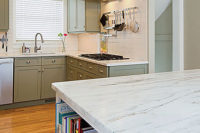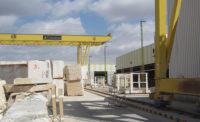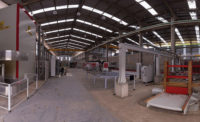While granite remains a popular choice for many homeowners, fabricators and stone distributors catering to the high-end residential market are finding their customers to be more design savvy and come into their showrooms with a desire for a material that is unique and not a mainstream stone variety. As a result, exotic stones are quite the trend these days, but education is important when it comes to working with these materials. Customers must be aware that many of these stones are fragile and difficult to cut, so they come with a higher price tag. But for those working with an upscale clientele, this does not seem to usually be an issue. People are willing to invest in quality and the beauty of natural stone.
“Interest in exotic stones is very high, especially in our Italian white marbles,” said Emily Holle, director of trend & design national marketing at M S International, Inc. (MSI). “The Italian white marble look is the hottest trend in the industry — the designer material of choice. We are finding that customers are looking for something unique to set them apart from the neighbors and are willing to upgrade on the surface that is seen most in a project.”
Holle explained MSI has an extensive collection of exotic and high-end stones and its customers are welcome to visit any of the company’s many North American distribution centers to view the slabs in-person. Additionally, MSI offers an online showing of its stone inventory on its website.
“There are some inherent risks of working with exotics, and at MSI, our knowledgeable sales staff is well educated on communicating the merits and risks of working with exotic natural stone,” Holle went on to say. “In addition, for our customers who like the look of premium exotics but desire superb durability, we offer a full range of Italian White marble and its counterparts in natural stone slabs, tiles, natural stacked stone panels, Q Premium Natural Quartz and Venetian engineered marble.”
What’s trending?
According to Holle, among the trending exotic materials are Calacatta Gold marble, Taj Mahal, Madreperola, Fusion, Azul Imperiale, Calacatta/White/Fantasy/Azul Macaubas, Sea Pearl and Onyx Bamboo. “[Also], our new quartzites such as White Nile, Allure, Amazonite and Calacatta ClassiqueTM Quartz are absolute showstoppers,” she said.
Holle believes the sale of exotic varieties is definitely on the rise. “Investment in kitchen and countertop remodels is one of the best ways to improve the resale value of a home, and as home prices continue to strengthen, consumers are gaining confidence to spend more in countertop materials,” she said. “We foresee this trend to continue and have prepared our showrooms and inventory investments to cater to this need.”
A fabricator’s perspective
Buddy Ontra of OntraStone in Bridgeport, CT, agrees the demand for exotic material today is high. As a fabricator, he started cutting exotics because his customer base was requesting it.
“In the early 2000s, Crema Bourdeaux was considered exotic,” he said. “Then came the schist material — Kosmus and Magma. My suppliers called them ‘granite’ when geologically they are not. Next came quartzite. My first Taj Mahal job was a net loss because of the extra time involved to fabricate it properly. When I received the customer selection sheet we were told it was granite, so I priced it that way. Live and learn. Pricing, scheduling and setting customer expectation are all considerations I take into account today.”
To ensure customers realize the difference between working with an exotic stone variety compared to a more traditional material such as granite, Ontra and his staff are dedicated to educating people about the material. “We take a considerable amount of time and effort to make sure our end user, not just the builder, designer or retail agent of sale, know exactly what to expect,” he said. “Seaming and vein flow, natural fissures and pits are some of the things we feel obligated to point out. We even have a ‘Natural Stone Characteristic’ sign off sheet for retail customers. ‘I know you told us about the fissures, but I didn’t think it would look like this’ is not something any of us want to hear — especially when waiting on a final payment.
Our pricing structure for these materials takes that risk into account. However, sometimes I do end up eating a slab.”
Ontra finds when comparing exotics to other stone types, aesthetics, particularly vein flow, play an important role. “Many times we give the customer the option of bringing in an additional slab — at an additional cost, of course — so we can work the flow and/or seams to their preference,” he said. “Also, we insist the customer comes to the shop to layout the templates.”
When it comes to the workability of exotics, it is a case-by-case basis. “White Macaubas, a quartzite, cuts very slowly but the edge polishes rather easily and quickly,” explained Ontra. “Taj Mahal, another quartzite but with a very different crystalline structure, and the schist materials, such as Kosmus, tend to chip a lot when cut, therefore more time is spent on finishing the edges.
“[When cutting], it used to be trial and error with quartzite and schist-type stones, but the R&D of our diamond blade manufacturers have come a long way to provide us with the proper tooling,” Ontra went on to say. “A smaller blade seems to cut better on some quartzites, and more water helps.”
Knowing the risks of working with exotics and being prepared in case there is damage to the stone during the handling or the fabrication process seems to be the consensus among many fabricators. “As we know, stone is very fragile and things happen,” said Fabio Figueiredo, president of La Pietra Custom Marble and Granite in Brookfield, CT. “We have seen everything. We try to prepare ourselves for the worst. Educating our customers is important. We find suppliers are calling everything a quartzite. Customers come in with the idea they are strong and don’t etch. We have to teach them.
“As a fabricator, you better test the stone and know about the stone you are going to work with,” Figueiredo continued. “Once cut, customers will call you — not the supplier. Customers can have selective hearing. You better have a contract. People don’t like paper, but it is everything you need to save your company’s reputation.”






